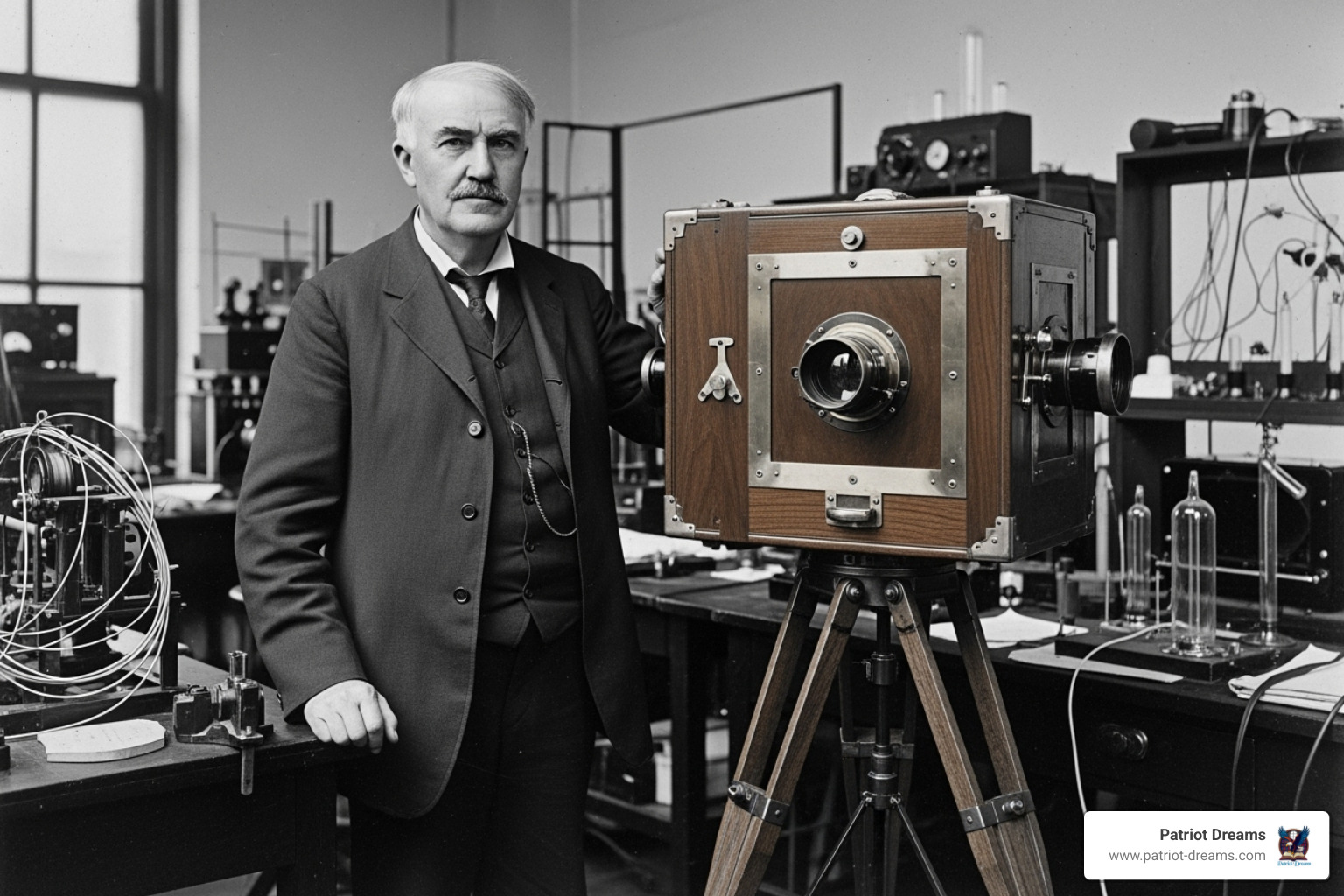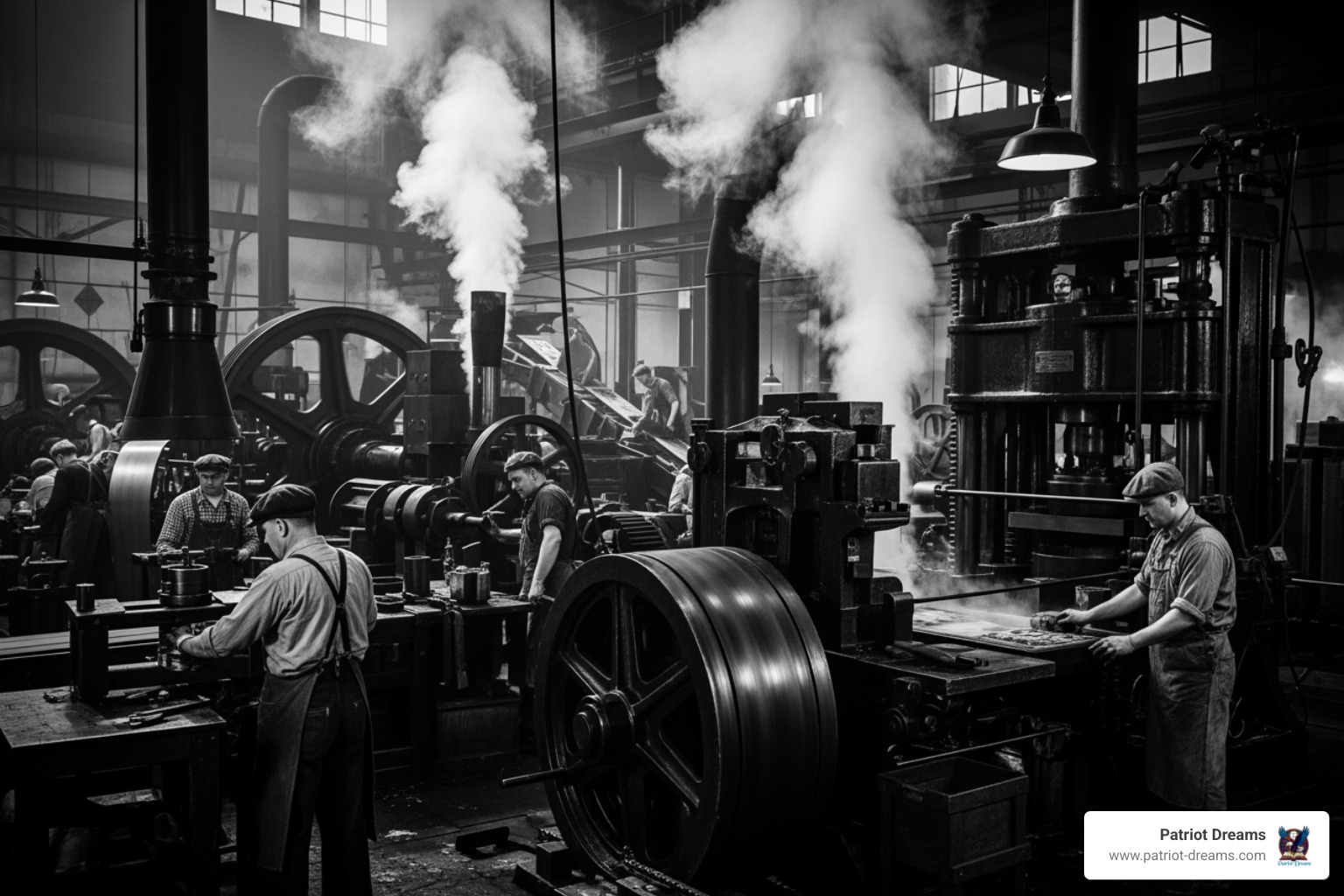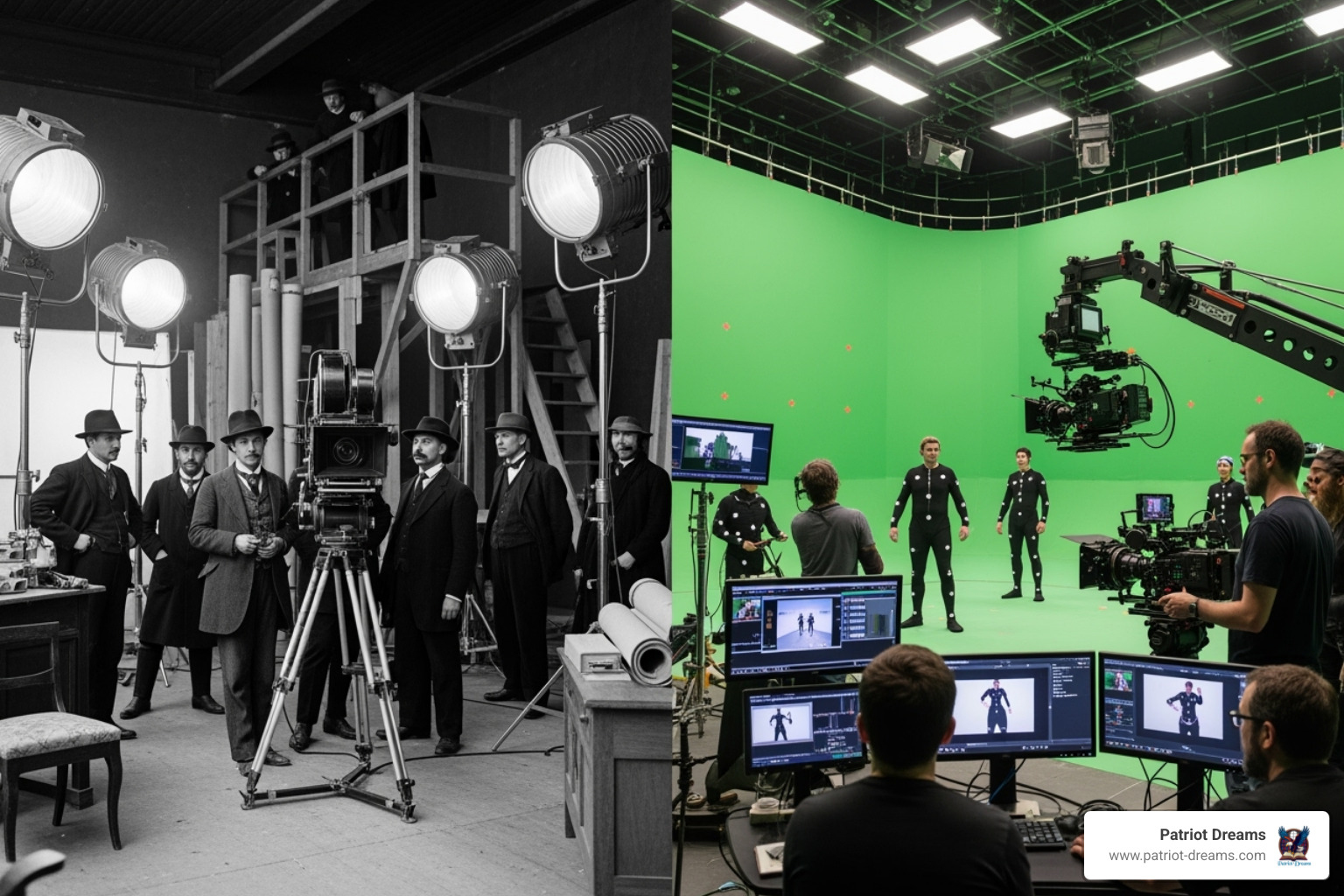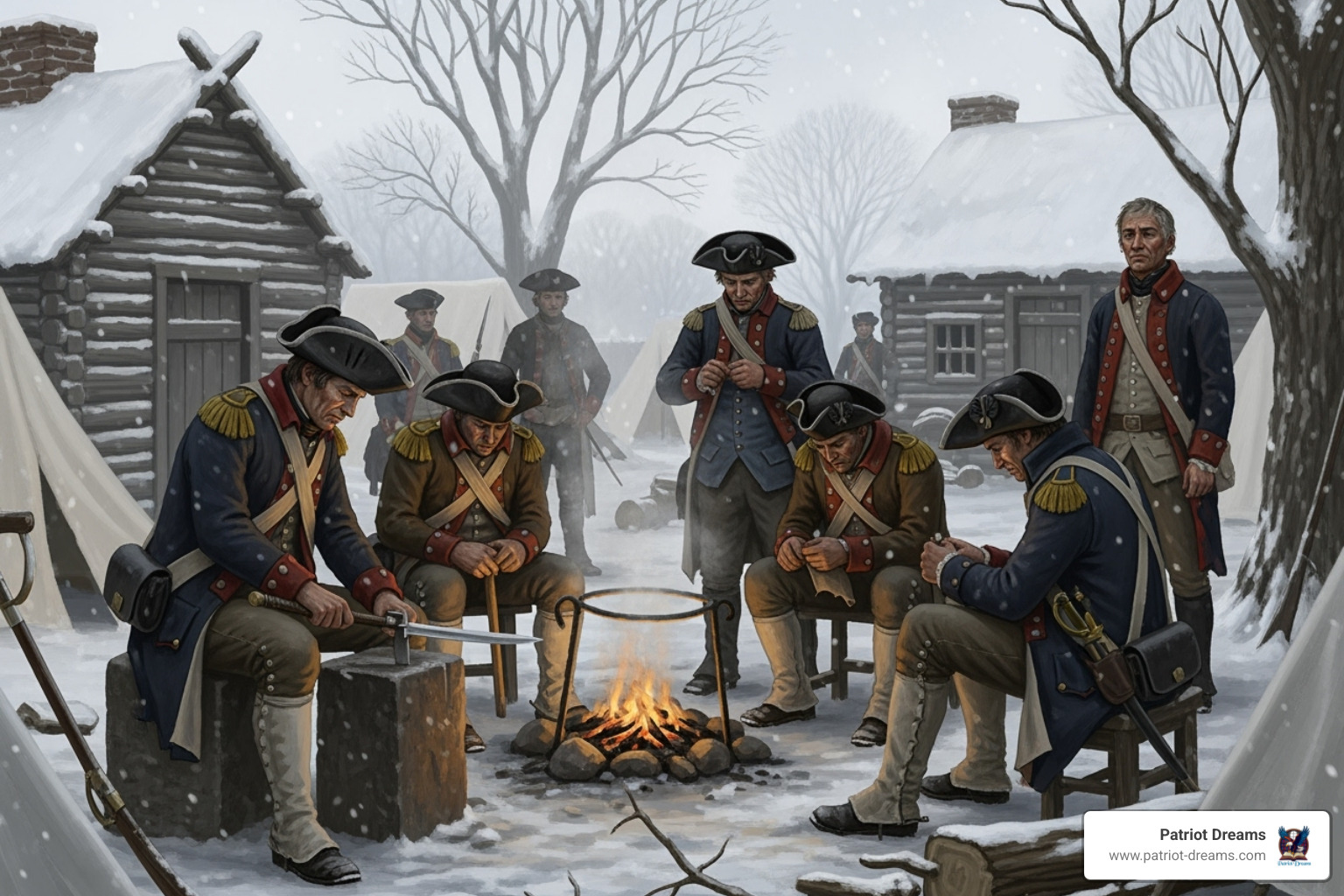The Industrial Ages in Hollywood: How Movies Portray America’s Manufacturing Boom


When the Silver Screen Met the Factory Floor
The Industrial Ages in Hollywood: How Movies Portray America's Manufacturing Boom tells a remarkable story of two revolutions happening at once. While America's factories hummed with unprecedented production, Hollywood itself became the nation's most famous factory—one that manufactured dreams instead of steel.
Key Ways Hollywood Portrayed America's Manufacturing Boom:
- The Dream Factory Model: Hollywood adopted assembly-line production methods from industry, creating the studio system that controlled every stage of filmmaking
- Heroic Worker Stories: Films celebrated everyday laborers, visionary industrialists, and lone inventors as symbols of American progress
- Regional Industrial Settings: Movies like Tugboat Annie (1933) and The Call of the Wild (1935) showcased logging, mining, and manufacturing across America
- Escapist Hope: During the Great Depression, films balanced industrial realities with uplifting narratives of resilience and community
- Technological Storytelling: The shift from silent films to "talkies" mirrored America's technological leap forward
Between the 1910s and 1960s, something magical happened. As America transformed from a nation of farms to a powerhouse of factories, Hollywood grew alongside it—using the same principles of mass production, efficiency, and innovation. The five major studios—Paramount, MGM, Warner Brothers, RKO, and Twentieth Century-Fox—controlled everything from production to the theaters where films played, just as industrial giants controlled their supply chains.
But Hollywood didn't just adopt industrial methods. It also portrayed them. From logging camps in Washington State to steel mills in Pittsburgh, movies brought the drama and dignity of American manufacturing to millions of moviegoers. These weren't always documentary-style portraits—Hollywood had a gift for turning factory workers into heroes and inventors into dreamers.
The result was a unique chapter in American storytelling, where the tools of industry created stories about industry, shaping how generations would remember this transformative era.

Handy The Industrial Ages in Hollywood: How Movies Portray America’s Manufacturing Boom terms:
Hollywood's Own Industrial Revolution: Building the Dream Factory
Here's something that might surprise you: The Industrial Ages in Hollywood: How Movies Portray America's Manufacturing Boom begins with Hollywood itself becoming a factory. While steel mills in Pittsburgh were perfecting their assembly lines, Hollywood was building its own production lines—ones that turned out dreams instead of automobiles.
The story starts with a familiar name: Thomas Edison. Back in 1887, Edison gave his assistant William K.L. Dickson an intriguing challenge. He wanted a machine "that should do for the eye what the phonograph did for the ear." What emerged was the Kinetograph, a camera that could capture moving images, and its companion viewing device, the Kinetoscope. These early marvels were limited—you had to peek into them one person at a time, like looking through a keyhole into another world. Around the same time, the Lumiere brothers in France created a portable camera and projector in 1894, and suddenly, moving pictures weren't just a novelty—they were the future.

In those early days, filmmaking happened mostly in places like Fort Lee, New Jersey. But Edison's Motion Picture Patents Company—what people called "the trust"—tried to control everything about the young industry. Independent filmmakers, tired of restrictions and legal battles, started heading west. California offered them something precious: year-round sunshine for filming, affordable land for building studios, and landscapes that could double for anywhere in the world. Hollywood, once a quiet agricultural community, was about to become the most famous factory town in America.
By the 1910s, something wonderful was happening. Filmmakers stopped simply pointing cameras at stage plays and started finding what movies could uniquely do. They experimented with different camera angles, built multiple sets, and developed editing techniques that could tell stories in ways theater never could. David W. Griffith, despite the controversial content of some of his work, showed the industry what was technically possible with films like The Birth of a Nation (1915). The language of cinema—how to show emotion, build tension, and move through time and space—was being invented right there on those California lots.
But the real change came when Hollywood acceptd industrial principles in its very structure. The studios began operating like the factories you'd find in Detroit or Cleveland, with every stage of production carefully organized for maximum efficiency. This approach, which scholars sometimes call "Fordist Mechanization," allowed Hollywood to produce thousands of films to feed an audience that couldn't get enough. It was American ingenuity and innovation applied to storytelling itself—a remarkable chapter in how our nation built not just products, but culture.
The Rise of the Studio System
Between 1930 and 1945, the studio system ran like a well-oiled machine. By 1929, eight studios controlled an astounding 95 percent of American film production. Five of these—Paramount, MGM, Warner Bros., RKO, and Twentieth Century-Fox—were what we call vertically integrated. They didn't just make movies; they distributed them and owned the theaters where you watched them. It was the same strategy John D. Rockefeller used with oil: control every step from start to finish.
These studios truly were factories. MGM alone employed thousands of people under long-term contracts—actors, directors, writers, carpenters, costume designers, all working together like shifts at a manufacturing plant. Each studio developed its own personality, its own brand. MGM became known for glamorous musicals and stories celebrating middle-class values. Warner Bros., often working with tighter budgets, created gritty crime dramas with shadowy lighting that spoke to working-class audiences.
The star system kept this factory humming. Contract players meant studios always had talent ready to work. Between 1930 and 1945, these dream factories produced more than 7,500 feature films. During the Great Depression, when every penny mattered, studios introduced the double feature—two movies for the price of one—keeping audiences coming back week after week.
It was efficient, sometimes rigid, but undeniably productive. Hollywood had mastered mass production for entertainment, applying the same principles that were changing every other American industry.
Technological Leaps in Storytelling
The technological breakthroughs in filmmaking during this era matched anything happening in other industries. The biggest game-changer came in 1927 with The Jazz Singer. For the first time, audiences heard synchronized dialogue and music coming from the screen. The introduction of sound didn't just change movies—it revolutionized them. Stories became more immersive, more accessible to everyone, including those who couldn't read title cards. By 1929, nearly every new film used sound.
But innovation didn't stop there. Filmmakers refined techniques like continuity editing, the 180-degree rule, and cross-cutting—tools that helped stories flow naturally from scene to scene. These weren't just technical tricks; they were a new grammar for storytelling.
The late 1930s brought us Gone with the Wind and The Wizard of Oz (both 1939), showcasing the stunning possibilities of Technicolor. Those vibrant hues weren't easy to achieve—the cameras were bulky, the process expensive—but the results were magical. Then came Orson Welles' Citizen Kane (1941), which pushed boundaries with deep-focus photography that kept everything sharp from foreground to background, and innovative sound design that made you feel like you were standing in the room.
These weren't just improvements—they were leaps forward. Every technological advance in Hollywood reflected the same spirit driving America's broader industrial age: the belief that tomorrow could always be better than today, that with enough ingenuity and hard work, we could create things nobody had imagined before. The Industrial Ages in Hollywood: How Movies Portray America's Manufacturing Boom was happening both on screen and behind the cameras, a testament to American creativity and determination.
On-Screen Marvels: How Movies Portray America's Manufacturing Boom
While Hollywood was busy building its own dream factories, something wonderful was happening on the silver screen itself. The cameras turned toward the very forces reshaping America—the factories, the mills, the logging camps, and the oil fields that were powering the nation forward. These films became windows through which everyday Americans could witness the remarkable changes happening across the country, from busy cities to remote frontier towns.

The Industrial Ages in Hollywood: How Movies Portray America's Manufacturing Boom wasn't just about showing factories—it was about capturing the human stories within them. Hollywood had a gift for taking the grand scale of steel mills, automobile factories, and resource extraction sites and making them feel personal. These weren't merely backdrops for action; they were characters in their own right, symbolizing both the promise of progress and the challenges that came with it.
The narrative threads that ran through these films often explored the tension between old ways and new. How did industrialization change small towns? What happened when the factory came to Main Street? Movies grappled with these questions, reflecting the mix of excitement and uncertainty that many Americans felt as their country transformed before their eyes.
Depicting the American Worker and Innovator
At the heart of Hollywood's industrial stories were the people who made it all happen. The films celebrated three types of heroes that audiences came to love: the hardworking factory employee, the bold industrialist, and the brilliant lone inventor.
The factory worker emerged as a genuinely heroic figure on screen. These weren't glamorous roles, but Hollywood found the dignity in them. Films showed men and women clocking in day after day, their hands building the cars, steel beams, and machinery that powered the nation. There was something beautiful in how these movies portrayed the camaraderie on the factory floor—the way workers looked out for each other, shared lunch breaks, and took pride in their craftsmanship. Even when the work was repetitive or demanding, these films honored the contribution of ordinary Americans to the country's prosperity.
The visionary industrialist was a more complicated character, and Hollywood wasn't afraid to show both sides. Sometimes these titans of industry appeared as ruthless empire-builders, driven by ambition above all else. But just as often, they were portrayed as dreamers who created jobs, built communities, and pushed America forward. Many of these stories followed the classic rags-to-riches arc, showing how a person with determination and vision could rise from nothing to change the world.
Then there was the lone inventor—perhaps the most beloved archetype of all. These characters embodied the American spirit of ingenuity that we celebrate in figures like Benjamin Franklin: Inventor, Diplomat, and Founding Father. They were the tinkerers in their workshops, driven by curiosity and a genuine desire to make life better for everyone. Hollywood loved showing these moments of breakthrough—the late night in the garage when everything finally clicks, the prototype that actually works, the invention that changes everything.
What made these stories so powerful was their emphasis on community and teamwork. Even the lone inventor usually had supporters—a loyal friend, an encouraging family member, a small-town banker who believed in the dream. The message was clear: American progress wasn't built by isolated individuals, but by people working together, supporting each other through setbacks, and celebrating victories as a community.
How Movies Portray America's Manufacturing Boom Through Genre
The beauty of Hollywood's approach was how it wove industrial themes through nearly every genre, each offering its own perspective on this transformative era.
Social problem films occasionally peeked behind the curtain at the harder realities of industrial life—labor disputes, challenging working conditions, or the strain of rapid urbanization. Yet Hollywood, especially under the Hays Code's moral guidelines, tended toward more uplifting approaches. Directors like Frank Capra mastered what we might call "populist fantasies," films that celebrated the common person's ability to stand up against powerful forces. While Mr. Smith Goes to Washington (1939) wasn't set in a factory, its spirit captured something essential about the industrial age—the belief that ordinary Americans, through courage and conviction, could shape their own destiny.
Musicals brought their own magical touch to industrial settings. Imagine a factory floor transformed into a stage, with workers breaking into synchronized dance numbers among the machinery. These films took the reality of industrial work and infused it with joy and spectacle, creating a sanitized but deeply entertaining vision of American productivity.
Westerns might seem far removed from factory floors, but they told crucial stories about America's industrial expansion. The logging camps of the Pacific Northwest, the mining operations digging for gold and silver, and the oil fields sprouting across Texas—all of these were industrial enterprises, just in rugged settings. The construction of railroads, featured in countless Westerns, represented one of the most massive industrial undertakings in American history, literally connecting the nation through steel and steam.
Even films like Charlie Chaplin's Modern Times (1936) offered commentary on the mechanization of work, showing both the humor and humanity in the age of mass production. Academic studies, including perspectives from The Work of Film in the Age of Fordist Mechanization, have explored how cinema uniquely captured the industrial process—from steam power to assembly lines—in ways that helped audiences understand and process these enormous changes.
Through all these genres and stories, Hollywood created a rich mix of how America's manufacturing boom looked, felt, and mattered to real people's lives. It's a legacy that continues to shape how we remember this pivotal era in our nation's history.
The Dream Factory: Balancing Reality with Escapism
Hollywood's Golden Age earned its nickname as the "dream factory" for good reason. Picture this: it's 1933, the Depression has hit hard, and families are struggling to make ends meet. Yet every week, millions of Americans would dress up, walk into ornate movie palaces, and lose themselves in stories of hope, adventure, and triumph. These weren't just theaters—they were temples of escapism, offering a precious few hours away from the weight of daily hardship.
But here's what made Hollywood truly remarkable during this era: it didn't ignore reality. Instead, it found a way to acknowledge the struggles of industrial America while still offering audiences the comfort and hope they desperately needed. The Industrial Ages in Hollywood: How Movies Portray America's Manufacturing Boom reveals this delicate balancing act—showing us how filmmakers walked a tightrope between truth and dreams.
The Great Depression coincided with Hollywood's boom years. Vertical integration made films cheaper to produce, and synchronized sound opened movies to everyone, including those who couldn't read. Suddenly, actors weren't just performers—they were stars, larger-than-life figures who represented what Americans aspired to be.
Yet this same period saw the implementation of the Motion Picture Production Code in 1934, better known as the Hays Code. Public pressure from groups like the Legion of Decency pushed Hollywood to clean up its act. The code forbade depicting adultery, excessive violence, profanity, and anything considered morally questionable. While this censorship limited creative freedom, it also created a shared moral framework that, oddly enough, helped streamline production and gave films a certain consistency that audiences found comforting.
Within these boundaries, Hollywood crafted narratives that reinforced the American Dream. Films acknowledged hard times but always pointed toward hope. Communities pulled together. Good people prevailed. The spirit of resilience shone through every story. This wasn't just entertainment—it was a lifeline, reminding audiences of their strength and capacity for renewal. Film became more than moving pictures; it shaped social and cultural history, reflecting and influencing how Americans saw themselves and their world.
Critical Perspectives and Uplifting Messages
Hollywood wasn't afraid to tackle tough subjects—it just approached them with care and ultimately, optimism. Labor issues occasionally made it onto the screen, even within the constraints of the Hays Code. You might see workers facing difficult conditions or standing up against unfair treatment, but these challenges became opportunities for heroes to emerge and communities to unite.
The focus was always on resolution and the triumph of the human spirit. A factory worker might struggle, but through determination and the support of fellow workers, justice would prevail. It wasn't a direct critique of the industrial system so much as a celebration of the people working within it.
Environmental themes surfaced in films set in resource-rich regions, particularly logging camps. God's Country and the Woman (1937), filmed in Washington State, explored the tensions between logging companies—the fierce competition, the camaraderie within camps, the feuds between rivals. While not an environmental film in today's sense, it touched on humanity's complex relationship with nature and the impact of industry on the land.
These stories consistently delivered uplifting messages about resilience during economic hardship, the strength found in community bonds, and the power of perseverance. They reminded audiences that they weren't alone in their struggles, and that together, Americans could overcome any challenge. It was exactly the message people needed to hear.
How Movies Portray America's Manufacturing Boom on the Frontier
Hollywood's quest for authenticity often led filmmakers far beyond California's soundstages. America's diverse landscapes—particularly those embodying the frontier spirit and resource extraction industries—became natural film sets during the Golden Age.
Washington State proved especially popular. Its rugged mountains, dense forests, and expansive waterfronts offered everything filmmakers needed. The state could stand in for Alaska, the Pacific Northwest, or any remote wilderness setting. Better yet, filming there created jobs during the Depression, making it a win-win situation.
Take MGM's Tugboat Annie (1933), which brought the maritime industry to life on Puget Sound. Over 5,000 Seattle residents volunteered as extras, thrilled to be part of Hollywood magic. The film showed the struggles of a tugboat family, capturing the grit and determination of people making their living on the water.
Twentieth Century Pictures' The Call of the Wild (1935) adapted Jack London's classic tale of the Alaskan gold rush, filming largely around Mt. Baker. The crew faced freezing temperatures, illness, and power outages—challenges that mirrored the harsh conditions faced by the gold seekers they were portraying.
Warner Bros.' God's Country and the Woman (1937) showcased the logging industry against Washington's magnificent forests. And Paramount's The Barrier (1937), set in the Alaskan tundra but filmed in Washington, hired unemployed local workers as extras and carpenters, paying them decent wages to build elaborate sets.
These productions captured industries like logging, fishing, and mining—all vital parts of America's manufacturing boom. More importantly, they celebrated the pioneering spirit: the determination to venture into unknown territories, the courage to face harsh conditions, and the deep connection between people and the land they worked. These stories of frontier resilience echo the inspiring narratives you'll find in American Pioneer Stories, reminding us of the enduring courage that built our nation.
A Lasting Blueprint: The Legacy of Hollywood's Industrial Age
Something remarkable happened when Hollywood turned its cameras toward America's factories, mills, and logging camps. Those films from the Golden Age didn't just entertain millions of moviegoers—they created a lasting image of who we were as a nation during one of our most transformative periods. Today, when we think about America's industrial past, we're often seeing it through the lens that Hollywood first polished and perfected.
The Industrial Ages in Hollywood: How Movies Portray America's Manufacturing Boom gave us more than just stories. These films shaped our collective memory, teaching generations about the grit and determination that built modern America. They introduced us to archetypes that still resonate: the heroic factory worker clocking in day after day, the visionary entrepreneur who saw opportunity where others saw only obstacles, the tight-knit communities that supported each other through hard times. These weren't just characters on a screen—they became part of our national story, reminding us of values like resilience, hard work, and the power of people coming together.

The spirit of innovation that powered both the industrial boom and Hollywood's own remarkable growth continues to pulse through American storytelling today. Modern filmmakers, even with their sophisticated CGI and digital wizardry, still draw from that same well. The themes haven't changed all that much, really. We still tell stories about ingenuity, about the human cost and triumph of progress, about ordinary people doing extraordinary things. The technology has evolved dramatically, but the heart of these narratives—the part that makes us lean forward in our seats—remains rooted in those foundational films from Hollywood's Golden Age.
What's particularly moving is how these films captured both the promise and the complexity of industrial America. They showed us the gleaming possibilities of progress while also honoring the everyday people who made it all possible. They reminded audiences, especially during the challenging Depression years, that Americans had faced hard times before and had always found a way forward together.
At Patriot Dreams, we see these connections between past and present as threads in a larger fabric—one that tells the story of American perseverance and creativity. The "dream factory" of Hollywood grew from the same innovative spirit that powered our manufacturing boom, and both continue to inspire us. These stories of community, determination, and the enduring American spirit aren't just history—they're part of who we are. We invite you to Explore more inspiring stories on our website and find how the echoes of our industrial past still resonate in the stories we tell today.
Join the Patriot Dreams Community
Download the app today and start your journey through American history and personal legacy.

Explore Our Latest Insights
Dive into stories that shape our American legacy.




